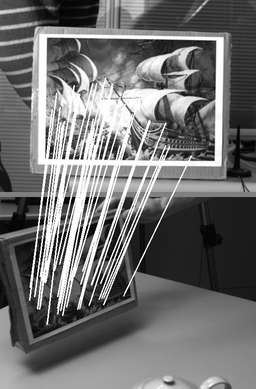BazAR is a computer vision library based on feature points detection and matching. In particular, it is able to quickly detect and register known planar objects in images. Well adapted to Augmented Reality applications, it is the result of advanced computer vision research.
Watch some calibration screen shots or augmented reality videos.
Downloads

Source code is available under the GNU General Public License. In short, if you distribute a software that uses BazAR, you have to distribute it under GPL with the source code. Another option is to contact us to purchase a commercial license.
- Unix archive: bazar-1.3.1.tar.gz
- Windows installer: bazar-1.3.1.msi
Documentation
- User manual (including installation instructions)
Who wrote BazAR ?
- Julien Pilet (author to contact if you have a question)
- Andreas Geiger
- Mustafa Ozuysal
- Vincent Lepetit
- Andre Mazzoni
How to get started with camera calibration and augmentation
Download and install bazar. To calibrate the camera, run the example called “singlecalib”. You will have to present a flat, rigid and textured surface to the camera, as fronto-parallel as you can. Press space, then ‘Y’. Model learning will start. After, simply move your calibration object in the field of view. After some time, calibration computation starts.
After calibration, it is possible to augment the video stream with a very basic 3d object. Just run the “Augment3D” sample.
How to get started with detection
Download the archive, install it, and run the sample program in bazar/samples/filedetector.
Under Windows, run: test.bat
Under UNIX, run : ./filedetector *jpg
Related Publications
Please note that the publication lists from Infoscience integrated into the EPFL website, lab or people pages are frozen following the launch of the new version of platform. The owners of these pages are invited to recreate their publication list from Infoscience. For any assistance, please consult the Infoscience help or contact support.
Keypoint Recognition using Randomized Trees
IEEE Transactions on Pattern Analysis and Machine Intelligence. 2006. Vol. 28, num. 9, p. 1465-1479. DOI : 10.1109/TPAMI.2006.188.Please note that the publication lists from Infoscience integrated into the EPFL website, lab or people pages are frozen following the launch of the new version of platform. The owners of these pages are invited to recreate their publication list from Infoscience. For any assistance, please consult the Infoscience help or contact support.